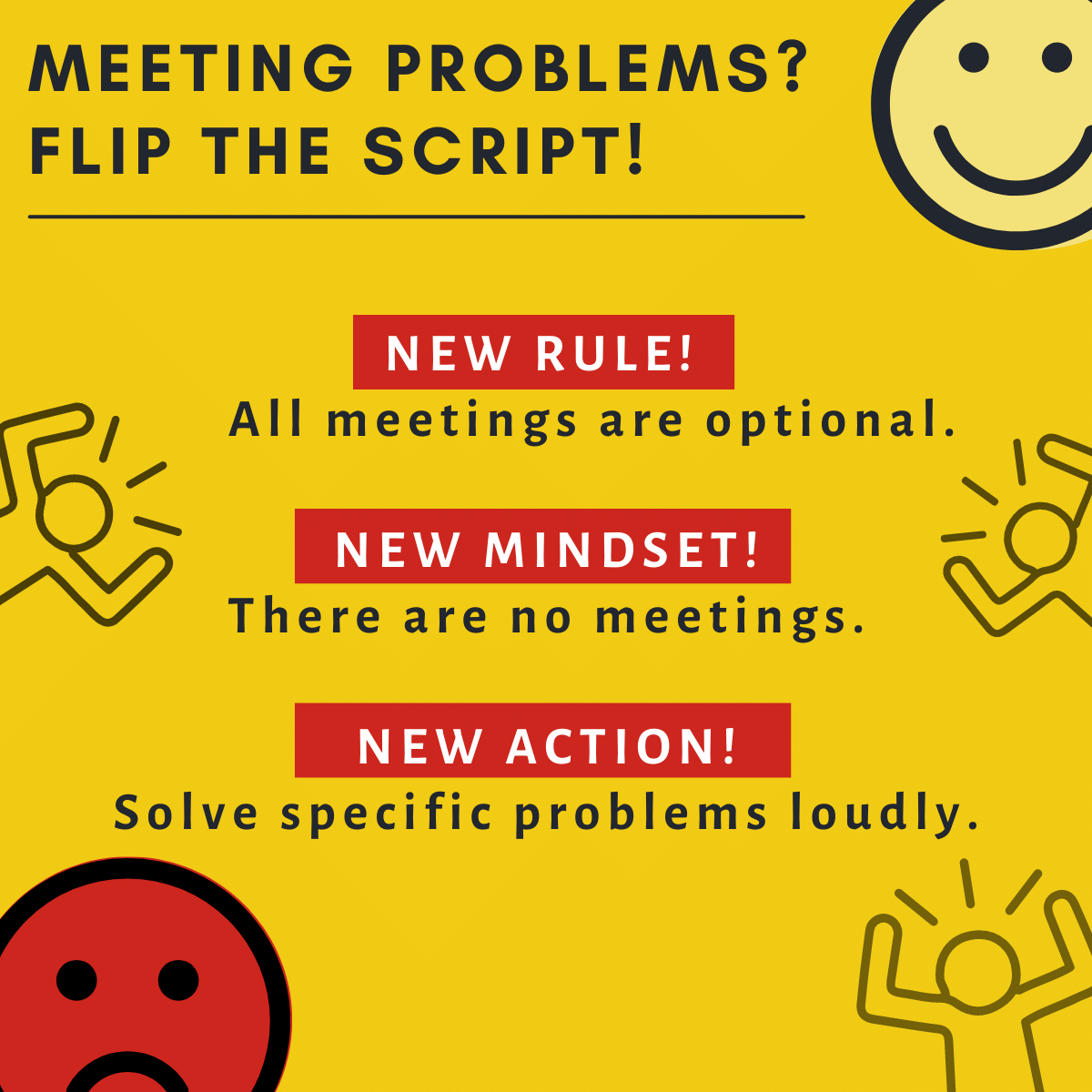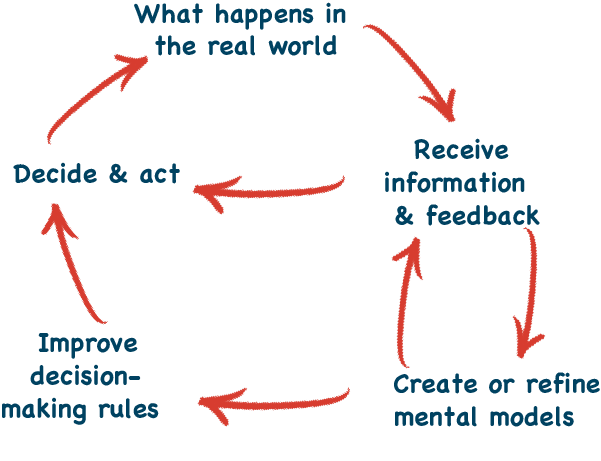3 Beliefs that Trap People in Chronically Bad Meetings (Survey Results)
A lot of people come to me for advice. And sometimes, when I listen to myself talking, I wish I could follow some of it.
~ Shah Rukh Khan (aka SRK) in an interview with David Letterman
In 2022, we posted a survey asking people for five obvious tips for running better meetings. To reinforce the “obvious” bit, here’s what we asked:
Imagine that you’ve agreed to help a child with a short school paper on the “Top Five Things Every Professional Needs to Know about Running Productive Meetings”. Which Top Five tips would you include?
We asked because there’s a standard set of meeting tips that are shared so often and in so many places that it seems most people must have seen them. We believe people already know what they’re “supposed” to do. They just aren’t consistently doing it.
We received over 400 tips. Five common themes emerged.
Five Obvious Tips Every Professional Should Know About Running Productive Meetings
- Have a clear objective and purpose for the meeting.
- Prepare an agenda and circulate it in advance to all attendees.
- Determine if a meeting is necessary before scheduling one and invite only relevant people.
- Ensure active participation and engagement from all attendees and keep the meeting focused on the agenda and the desired outcomes.
- End on time, recap action items and follow up with attendees afterward.
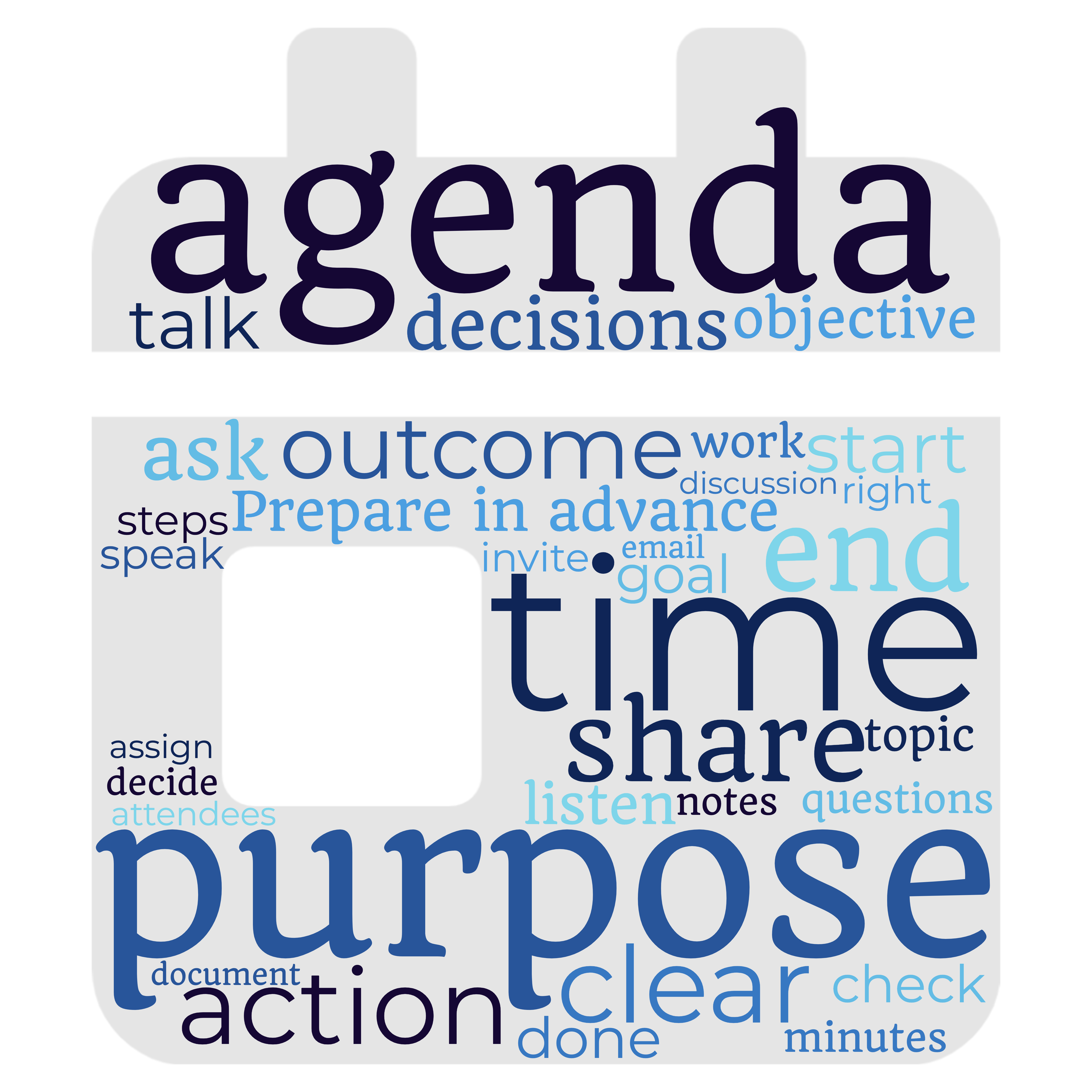
Oh good! We’re not imagining things. People really do seem to know the basic advice.
They should! These tips are not new. The oldest meeting manual on my bookshelves includes these tips. It was first printed in 1897. So heads up bloggers of the world: You can write more interesting articles now! This one’s been done.
The working world largely agrees on what makes meetings productive. The basic advice hasn’t changed much in over 1000 years. You’d think we’d have it down by now, but we all know that’s not the case.
We know there’s a gap between the advice people give and what they do themselves. SRK is not alone in this. To see how big that gap might be, our survey asked two follow-up questions. The first:
In your current organization, what percentage of meetings do you believe follow this Top 5 advice?
The average responses?
- 45% for all meetings across the organization
- 67% of the meetings led by the respondent
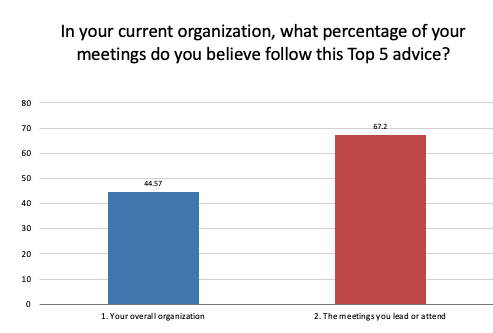
These numbers are disturbing low because our surveys tend to attract lots of meeting experts. In this case, 74% of the people taking the survey said that they’re most often in the role of a senior executive, leader, or outside expert.
If these leaders aren’t consistently following this advice, is anyone? Short answer: Yes.
Averages can be deceiving. When we look at the range of answers, you can see that 17% estimated that more than 75% of their organization’s meetings consistently followed this “obvious” advice.
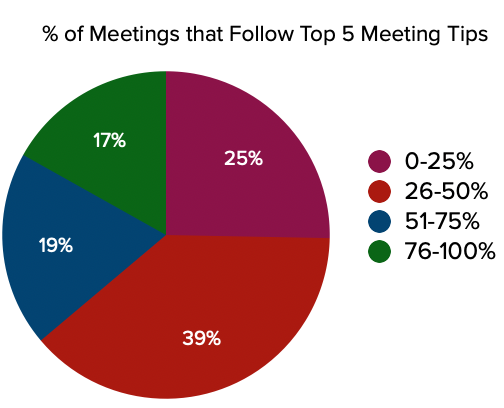
That’s actually a bit lower than I expected based on the sample and our pre-pandemic research (see this, and this), but it’s still leagues beyond impossible.
Once again, it is possible for organizations to enjoy consistently effective meetings.
Still, this leaves us with a significant gap between what most people supposedly know and what they do.
Why the gap? What’s getting in the way?
The Gap Between Knowing What to Do and Doing It
Whether you believe you can do a thing or not, you are right.
— Henry Ford
For years, I believed the issue was ignorance. I thought folks must endure lousy meetings because they didn’t know any better!
While this may be true for some junior employees, I no longer think ignorance is at the core. As the top-tip advice demonstrated, most people say reasonable things when asked to list five obvious tips for running better meetings. I’ve asked children, strangers on the bus, people at networking events, and laborers who rarely go to meetings, and they all offer decent-sounding advice.
The basic knowledge is out there, yet the chasm between knowing and doing persists. Many people know what they should be doing, but they aren’t doing it.
We asked our survey respondents about what they believe creates that gap in their organizations. Specifically:
Thinking about your organization and these Top 5 tips, if meetings do not consistently follow these tips, why might that be?
Here are the top themes.
- Lack of buy-in from attendees and leadership.
- A lack of clear guidelines and training.
- Other people fail to prepare, follow through, or set a clear purpose and agenda, leading to low-quality outcomes.
- A general lack of motivation towards meetings.
- Short version: Other people!

This will not surprise the psychologists amongst you. Humans are susceptible to a “blindspot” that suggests any failure on our part is due to uncontrollable circumstances. Our meetings are great – except maybe not perfect when we’re too busy, stressed, tired, or otherwise thwarted by understandable obstacles.
At the same time, we may believe other people fail because they’re lazy, selfish, unintelligent, controlling, or mean – and sometimes all of the above!
When people in an organization experience chronic meeting pain, they witness other people behaving in less-than-awesome ways. This seeds three powerful limiting beliefs.
Three Limiting Beliefs About Business Meetings
1. Meetings suck. Full stop.
As in, water is wet.
Many people seem to believe that bad meetings are in our nature – just a fact of life akin to gravity and death, and their curiosity stops there.
A survey answer reflecting this belief:
Many MANY supervisors who lead meetings apparently have never been told how to lead them well, never had formal training, or – as poor-participants themselves – they allow or participate in these things as leaders. Many leaders seem to fall into these habits because it is COMFORTABLE.
For example, they’ll have a triangulated discussion with 2-3 other people out of a group of 20-50 because they don’t feel able to address a bigger group, or they’ll fail to ask for input since they feel comfortable with their idea and don’t want it questioned or changed.
They’ve never been told how to lead meetings well?!?!?
Why are people waiting around for someone to tell them how to spend their own time more productively? We are a society that can find a great restaurant in a foreign city in minutes. But we don’t expect meeting leaders to Google “how to make meetings better?”
That’s ridiculous. The information isn’t hard to find for anyone who looks. The trick is, they have to believe better meetings just might be possible before they’ll get curious enough.
This limiting belief also manifests as:
We’re cancelling all our internal meetings so we can get work done.
If you believe that meeting is the opposite of doing work and that meetings are by nature bad things, then the only sensible response is to eliminate as many meetings as you can.
Leaders who embraced the “meetings suck” belief at Shopify, Salesforce, Nike, Slack, and many other companies could then play the hero by dramatically canceling all those evil meetings and rescuing their employees’ calendars.
Of course, since meetings are often useful and necessary, employee calendars quickly fill up again. Like Sisyphus, those heroes never achieve the victory they seek.

The belief that “Meetings Suck” traps people in bad meeting cultures because it kills curiosity. It assumes that better meetings don’t exist, so there’s no reason to pursue them.
You and I know better. We know that not all meetings suck. Actually, lots of people know this. Lots of these people even know what an effective meeting looks and feels like.
Despite knowing better, however, folks may endure regularly awful meetings because they believe…
2. It’s not my place to make a change.
We learn what’s acceptable in a group by attending that group’s meetings. If the people in charge do a poor job of it, they’re unlikely to know how others feel unless they specifically ask.
Here’s a survey response demonstrating the “not my place” belief in action:
We are too nice to one another and don’t hold each other accountable for eliciting meeting behavior etiquette, even after its discussed at company meetings.
I encountered this belief most forcefully when leading a private workshop. The company’s management brought me in to help their project leaders improve the meetings in the project lifecycle. As we neared the end of a workshop, one frustrated project manager burst out:
I don’t understand why we’re doing this! Sure, I’d love to run my meetings the way we learned here, but that’s not how we do it at this company! If leadership wanted us to run better meetings, they’d tell us – but I haven’t heard anything from them about this.
Without a leadership mandate, nothing will change. We’re wasting our time.
I was stunned. First, because the leadership group hired me to help them, I wondered – what more of a “mandate” did they need?!
More importantly, this statement revealed a belief that the meetings were bad at the company because that’s how leadership wanted them to be, and if they wanted a change, they’d say so. It wasn’t the project teams’ place to say otherwise.
The belief that it’s not my place to make a change traps people in bad meeting habits (and many more ineffective habits) because it reflects a culture where people feel that it’s unsafe to suggest improvements.
Those project leaders knew their meetings were boring and knew exactly how to improve them, but they wouldn’t try because they didn’t believe they had the authority.
So, does that mean people who know how to lead great meetings and clearly have the authority to do so have it easy?
Not necessarily. They may be prone to the third limiting belief.
3. It’s not possible for meetings to work well across an entire organization.
Senior leaders – think COOs, CMOs, & SVPs – who lead highly effective meetings within their departments know that they can create a great team culture.
Still, they may not believe it’s possible to spread these good habits to other parts of the organization.
Sometimes, this belief has to do with the person at the top.
We have a CEO with narcissistic tendencies who has no goal-awareness and has never worked in a disciplined organization. Rambling and mental frolics are common.

More often, though, this belief reflects the experience of a leader who has never worked in an organization with healthy meeting habits. They don’t believe organization-wide effectiveness is possible because they’ve never seen it.
They lack vision.
This belief keeps them trapped in an environment where the only quality meetings they can rely on are the ones they control. They stay mute when they see other leaders operating ineffectively, leaving everyone else free to squander the company’s time.
Liberating Limiting Beliefs
If you’re trying to improve your organization’s meeting culture, you will encounter these beliefs and they will impede your progress.
People who don’t believe that meetings can be great will never prioritize improving them. You must shift these beliefs to make progress.
Happily, you can. We’ll explore a few strategies you can start with in a future article.


